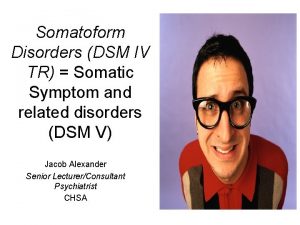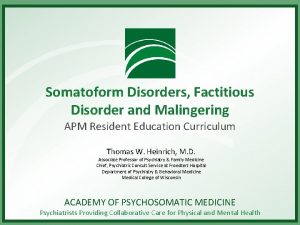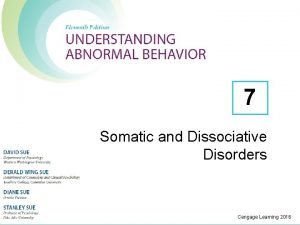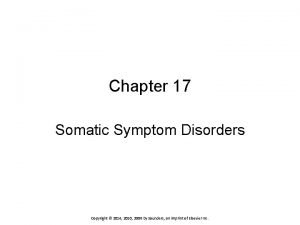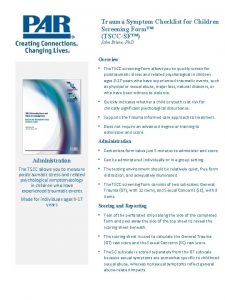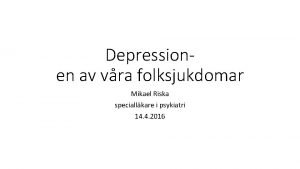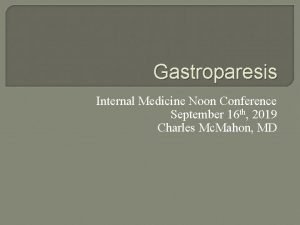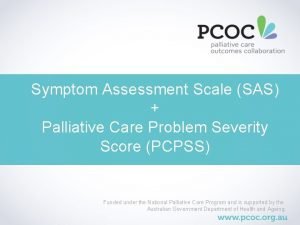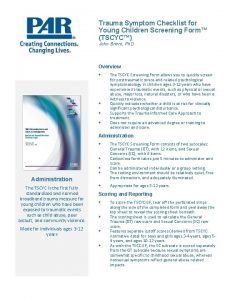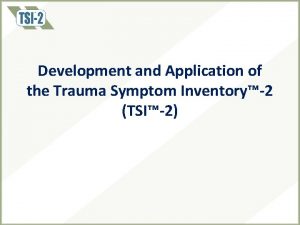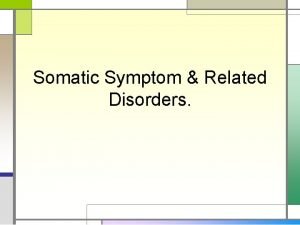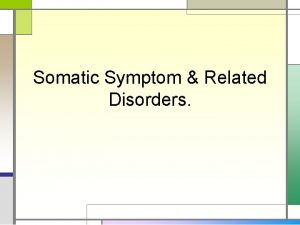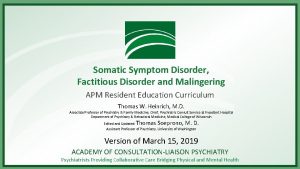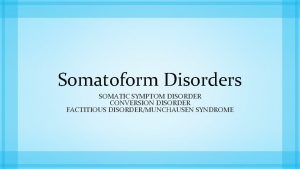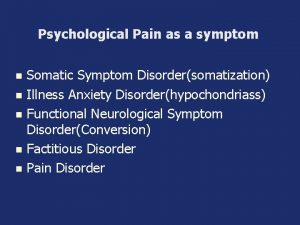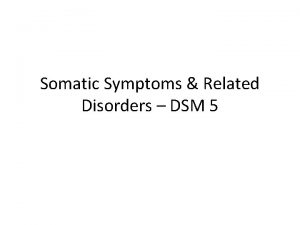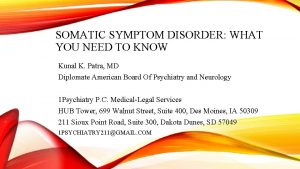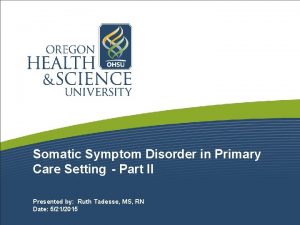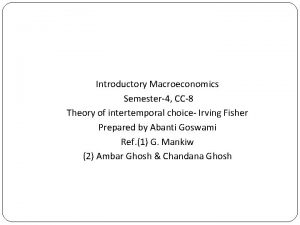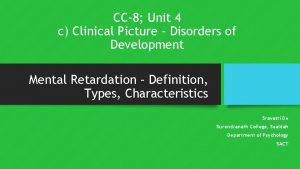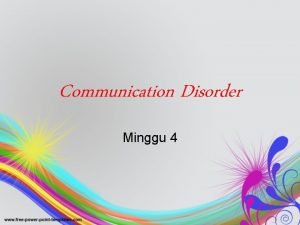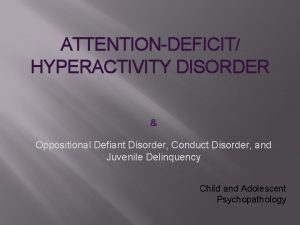SemesterIV CC8 Somatic symptom disorder A somatic symptom














- Slides: 14

Semester-IV CC-8

Somatic symptom disorder

A somatic symptom disorder, formerly known as a somatoform disorder, is any mental disorder that manifests as physical symptoms that suggest illness or injury, but cannot be explained fully by a general medical condition or by the direct effect of a substance, and are not attributable to another mental disorder (e. g. , panic disorder). Somatic symptom disorders, as a group, are included in a number of diagnostic schemes of mental illness, including the Diagnostic and Statistical Manual of Mental Disorders. (Before DSM-5 this disorder was split into somatization disorder and undifferentiated somatoform disorder. )

The somatoform disorders are a group of psychological disorders in which a patient experiences physical symptoms that are inconsistent with or cannot be fully explained by any underlying general medical or neurologic condition. Medically unexplained physical symptoms account for as many as 50% of new medical outpatient visits. Physical symptoms or painful complaints of unknown etiology are fairly common in pediatric populations. Many healthy young children express emotional distress in terms of physical pain, such as stomachaches or headaches, but these complaints are usually transient and do not effect the child's overall functioning. The somatoform disorders represent the severe end of a continuum of somatic symptoms.

Somatization in children consists of the persistent experience and complaints of somatic distress that cannot be fully explained by a medical diagnosis. They can be represented by a wide spectrum of severity, ranging from mild selflimited symptoms, such as stomachache and headache, to chronic disabling symptoms, such as seizures and paralysis.

Somatic symptom disorder (SSD formerly known as "somatization disorder" or "somatoform disorder") is a form of mental illness that causes one or more bodily symptoms, including pain. The symptoms may or may not be traceable to a physical cause including general medical conditions, other mental illnesses, or substance abuse. But regardless, they cause excessive and disproportionate levels of distress. The symptoms can involve one or more different organs and body systems, such as:

• Pain • Neurologic problems • Gastrointestinal complaints • Sexual symptoms Many people who have SSD will also have an anxiety disorder. People with SSD are not faking their symptoms. The distress they experience from pain and other problems they experience are real, regardless of whether or not a physical explanation can be found. And the distress from symptoms significantly affects daily functioning. Doctors need to perform many tests to rule out other possible causes before diagnosing SSD.

Disorders Related to Somatic Symptom Disorder Several conditions related to SSD are now described in psychiatry. These include: • Illness Anxiety Disorder (formerly called Hypochondriasis). People with this type are preoccupied with a concern they have a serious disease. They may believe that minor complaints are signs of very serious medical problems. For example, they may believe that a common headache is a sign of a brain tumor.

• Conversion disorder (also called Functional Neurological Symptom Disorder). This condition is diagnosed when people have neurological symptoms that can't be traced back to a medical cause. For example, patients may have symptoms such as: Ø Weakness or paralysis Ø Abnormal movements (such as tremor, unsteady gait, or seizures) Ø Blindness Ø Hearing loss Ø Loss of sensation or numbness Ø Stress usually makes symptoms of conversion disorder worse.

• Other Specific Somatic Symptom and Related Disorders. This category describes situations in which somatic symptoms occur for less than six months or may involve a specific condition called pseudocyesis, which is a false belief a woman has that she is pregnant along with other outward signs of pregnancy, including an expanding abdomen; feeling labor pains, nausea, fetal movement; breast changes; and cessation of the menstrual period.

Diagnostic and Statistical Manual of Mental Disorders: Somatic symptom disorders used to be recognized as Somatoform disorders in the Diagnostic and Statistical Manual of Mental Disorders of the American Psychiatric Association. The following[11] were conditions under the term Somatoform Disorders:

• Conversion Disorder: A somatic symptom disorder involving the actual loss of bodily function such as blindness, paralysis, and numbness due to excessive anxiety. • Somatization disorder • Hypochondriasis • Body dysmorphic disorder: wherein the afflicted individual is concerned with body image, and is manifested as excessive concern about and preoccupation with a perceived defect of their physical appearance. • Pain disorder • Undifferentiated somatic symptom disorder – only one unexplained symptom is required for at least six months.

In the newest version of DSM-5 (2013) somatic symptom disorders are recognized under the term Somatic Symptom and Related Disorders: • Somatic symptom disorder: Will take over many of what was formerly known as somatization disorders and hypochondriasis (hyperchondiac) • Factitious disorder: Can be either imposed on oneself, or to someone else (formally known as factitious disorder by proxy). • Illness anxiety disorder: A somatic symptom disorder involving persistent and excessive worry about developing a serious illness. This disorder has recently gone under review and has been altered into three different classifications. • Somatoform disorder not otherwise specified (NOS) Included among these disorders are false pregnancy, psychogenic urinary retention, and mass psychogenic illness (so-called mass hysteria). Somatization disorder as a mental disorder was recognized in the DSM-IV-TR classification system, but in the latest version DSM-5, it was combined with undifferentiated somatoform disorder to become somatic symptom disorder, a diagnosis which no longer requires a specific number of somatic symptoms.

International Statistical Classification of Diseases and Related Health Problems: The ICD-10, the latest version of the International Statistical Classification of Diseases and Related Health Problems, classifies conversion disorder as a dissociative disorder. ICD-10 still includes somatization syndrome.
 Somatization disorder dsm 5
Somatization disorder dsm 5 Somatic symptom
Somatic symptom Somatic symptom disorder
Somatic symptom disorder Nursing diagnosis of somatoform disorder
Nursing diagnosis of somatoform disorder Factitious disorder
Factitious disorder Somatic symptom and related disorders
Somatic symptom and related disorders Chapter 17 somatic symptom disorders
Chapter 17 somatic symptom disorders Somatic sx disorder
Somatic sx disorder Tscc score sheet
Tscc score sheet Esas symptom assessment
Esas symptom assessment Monoaminhypotesen
Monoaminhypotesen Gastroparesis cardinal symptom index calculator
Gastroparesis cardinal symptom index calculator Symptom assessment scale palliative care
Symptom assessment scale palliative care Trauma symptom checklist for children™ screening form
Trauma symptom checklist for children™ screening form Trauma symptom inventory 2
Trauma symptom inventory 2

